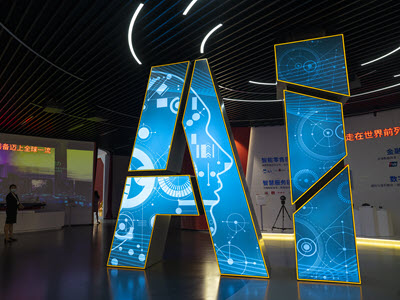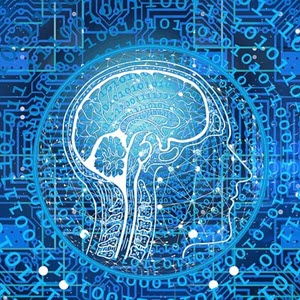Commentary
China’s Approach to AI Development and Governance
Ren Xiao examines how China is dealing with the issue of AI governance, both domestically and internationally. He argues that the best path forward for the United States and China to expand access to advanced technology such as AI is through cooperation rather than competition.
Artificial intelligence (AI) is a new technological frontier that has wide-ranging economic, political, and military implications that could lead to changes in the global balance of power. The People’s Republic of China has embraced AI and enthusiastically attempted to advance it as part of the country’s drive to become a self-strengthening scientific and technological power. As a result, China is in many areas at or near the forefront of AI development and application. However, as global AI governance becomes a higher priority in the international community, China, like others, is grappling with the question of how to govern AI and its advancement, both domestically and internationally.
China’s Embrace of AI
In May 2015, China released the Made in China 2025 plan, which provided a blueprint for the next decade to establish the country as an advanced manufacturing powerhouse. The plan identifies nine strategic tasks and key areas, including enhancing manufacturing innovation, promoting integration of information technology and industry, strengthening the country’s industrial base, and building quality and brand development. Almost all of these priorities are directly related to or impacted by the development of AI. Thus, AI has become the core technology indispensable for future intelligent manufacturing and China’s economic plans in this space. The Made in China 2025 plan, together with the subsequent “Robotics Industry Development Plan (2016–2020),” released in April 2016, and the “‘Internet Plus’ Artificial Intelligence Three-Year Action and Implementation Plan,” released in May 2016, demonstrated that China has elevated developing AI technology to a level of national strategy.
Furthering the above-mentioned plans and measures, China issued “The Development Plan for the New Generation Artificial Intelligence” in July 2017, and “The Ethical Norms for the New Generation Artificial Intelligence” in September 2021. The former puts forward a three-step strategy for China to reach an internationally advanced level in AI by 2020, realize a major breakthrough in foundational theory by 2025, and become one of the major AI innovation centers in the world by 2030. The latter aims to integrate ethics into the entire lifecycle of AI and to provide ethical guidelines for individual, enterprises, and other related organizations engaged in AI-related activities. In August 2023, China further stipulated “Interim Measures for the Management of Generative Artificial Intelligence Services.” The measures aim to promote the healthy development and regulated use of generative AI, preserve network security and societal public interest, and protect the lawful rights and interests of citizens, legal persons, and other organizations.
China’s AI development efforts resulted in a major technological breakthrough in 2025 with the debut of the DeepSeek-R1 AI model, which challenged previous assumptions about U.S. dominance in AI development and innovation. DeepSeek-R1 uses an open-source AI model, whereas the leading models from U.S. companies are generally closed-source. Open-source models make it more possible for other countries, particularly those in the global South, to have an opportunity to benefit from global technology development. This helps break the winner-take-all situation in the high-tech domain and enables AI technologies to be developed and utilized more widely.
Two American scholars, Amy Zegart and Emerson Johnston, examined the academic and professional pathways of over two hundred researchers affiliated with DeepSeek.[1] They found that nearly all these researchers were educated or trained in China, over half never left China for schooling or work, and of the nearly 25% who did gain some experience in the United States, most returned to China. This finding demonstrates the educational and technological progress China has made and raises significant questions for U.S. policymakers concerned about the trajectory of U.S.-China technology competition.
The application of AI has become increasingly wide-ranging in various Chinese industries and across society as whole. In March 2024 the Chinese premier’s annual government work report for the first time proposed to implement “AI Plus” action measures in order to take advantage of new technology. The 2025 government work report again vowed to advance the AI Plus initiative. To this end, it pledged to support the extensive application of large-scale AI models and vigorously develop new-generation intelligent terminals and smart manufacturing equipment, including intelligent connected new-energy vehicles, AI-enabled phones and computers, and intelligent robots. In July 2025, the Chinese government released its “Opinions on Deepening the Implementation of Artificial Intelligence Plus Action.”
The government has decided to prioritize three main aspects of AI development: the first is industrial empowerment (chanye fu nen) to allow AI to be utilized in industry, agriculture, and services as much as possible; to actively support the development and application of AI models in vertical areas; and to let the upgrade of AI empower new quality productive force (xinzhi shengchanli). The second is AI applications (zhongduan yingyong) through digital technologies to reinforce intelligent networking of cars, cell phones, computers, and robots for a new round of rapid development. This aims to better integrate AI with ordinary people’s daily lives to let them enjoy an intelligent life. The third is utilization scenarios (changjing peiyu), which seeks to demonstrate AI implementation in terms of new technologies, new scenarios, and new business formats (for example, in low-altitude economy, education, training, and medical areas).
China and Global AI Governance
Globally, the rapid growth of AI has posed both an opportunity and a challenge to the international community. How should AI be utilized in favor of people and society while avoiding harms? Just as technological advancements were made in the past, AI has emerged as a revolutionary technology and is progressing at a breathtaking pace. The implications of this new paradigm for humanity will be a key question for the international community. From the very beginning, China has been involved in international rulemaking and coordination in AI regulation, which can be broadly divided into three categories of engagement.
The first category comprises initiatives coordinated by international organizations or groupings such as the United Nations, the Organisation for Economic Co-operation and Development (OECD), and BRICS. Such engagement focuses on providing principled rules and guidance for the technological risks related to the three core pillars of AI (i.e., data, algorithms, and computing power). The second category is global AI summits and the G-20, which have focused on regulations and security risks brought about by the development of AI technology. Since 2023, global AI summits have been held in Bletchley, Seoul, and Paris. The third category is bilateral coordination involving China and other nations, focusing on AI risk management, AI governance and patterns, and AI technology export controls across various applications and domains.[2]
At all three levels of engagement on global AI governance, China has advocated for a people-centered approach and the principle of “AI for good.” Chinese priorities include enhancing the understanding of all countries on AI ethics and ensuring that AI is safe, reliable, controllable, and capable of better empowering global sustainable development and enhancing the common well-being of all mankind.[3]
China also advocates to increase the representation and voice of developing countries in global AI governance and ensure equal rights, opportunities, and rules for all countries. More advanced countries should make efforts to conduct international cooperation with and provide assistance to less “literate” ones in order to bridge the gap in AI and its governance capacity. In addition, China supports continuing discussions within the UN framework to establish an international institution to govern AI and to coordinate efforts to address major issues concerning international AI development, security, and governance.
China unveiled the Global AI Governance Initiative in October 2023. This initiative emphasized that all countries, regardless of their size, strength, or social system, should have an equal right to develop and use AI. Efforts should be made to conduct international cooperation with and provide assistance to developing countries so as to bridge the gap in AI and its governance capacity. Since then, China has advocated that countries put equal emphasis on development and security. In September 2024, it introduced the “AI Capacity-Building Action Plan for Good and for All.” This plan outlined key areas for collaboration with international partners on AI governance, including infrastructure development, industrial empowerment, talent training, data management, and security governance.
In July 2025, China hosted the World AI Conference and High-Level Meeting on Global AI Governance, which centered on the theme “global solidarity in the AI era.” The three-day event drew over 1,200 industry leaders, government officials, researchers, and investors from around 30 countries. During the conference, the Chinese government proposed the creation of a global AI cooperation organization headquartered in Shanghai. This proposal would give China a leading role in upholding multilateralism and promoting global governance through consultation, joint construction, and shared benefits. China also issued an action plan for global AI governance, inviting governments, international organizations, enterprises, and research institutions to work together and promote international exchanges, including through a cross-border open-source community.
AI in U.S.-China Relations
Although the Chinese government’s position is that AI should be a tool for global collaboration rather than geopolitical competition, many observers view China’s AI development through the prism of U.S.-China competition. The “2025 Global AI Governance Action Plan” was released just days after the Trump administration announced the United States’ action plan for AI. A Global Times editorial highlighted some perceived differences between the two countries’ approaches, noting that the U.S. plan “includes further tightening of export controls on AI chips to China” and arguing that “the United States remains trapped in a zero-sum mind-set, pursuing a fantasy of maintaining AI hegemony through technological blockades.”[4] Such “competition” could have complex and significant implications for the rest of the world.
Overall, the world’s two preeminent powers and largest economies must build a constructive relationship on AI for the world and for themselves. The Chinese government believes zero-sum thinking is detrimental, and that it is harmful to politicize AI and to frame everything, including AI, as part of a competition between democracy and autocracy. One fundamental task facing the global community today is to narrow, if not completely eliminate, the digital and AI divides. This is also the responsibility of the world’s major powers. The best path forward to expand access to advanced technology such as AI is through cooperation rather than competition.
Ren Xiao is a Professor of International Politics in the Institute of International Studies at Fudan University in Shanghai and Director of the Center for the Study of Chinese Foreign Policy.
Endnotes
[1] Amy Zegart and Emerson Johnson, “Policy Implications of DeepSeek AI’s Talent Base,” Stanford Institute for Human-Centered AI, Policy Brief, May 6, 2025, https://hai.stanford.edu/policy/policy-implications-of-deepseek-ai-talent-base.
[2] Cheng Haiye, “Global Artificial Intelligence Regulation: Rule Construction and Multiple Challenges,” Journal of International Relations, no. 3 (2005): 115–18.
[3] Ministry of Foreign Affairs of the People’s Republic of China, “Position Paper of the People’s Republic of China on Strengthening Ethical Governance of Artificial Intelligence (AI),” November 2022, https://www.fmprc.gov.cn/eng/zy/wjzc/202405/t20240531_11367525.html.
[4] “‘Promoting Global Solidarity’ Provides a Chinese Solution for AI Governance,” Global Times, July 27, 2025, https://www.globaltimes.cn/page/202507/1339411.shtml.



